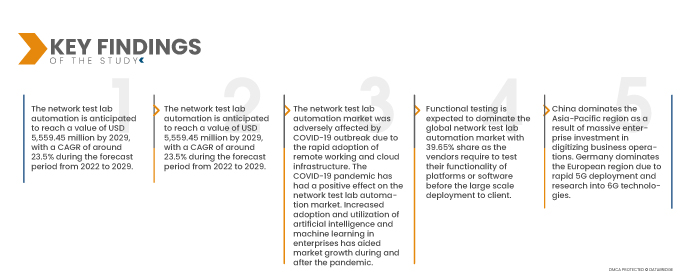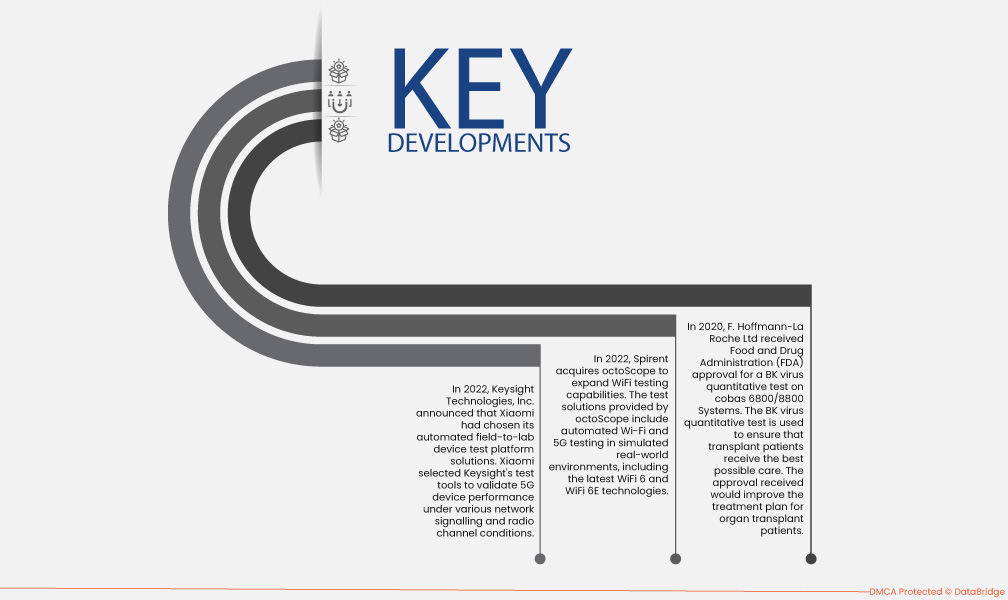في العقدين الأخيرين، تطورت مختبرات الأبحاث وعلم الأمراض بشكل ملحوظ. هناك طلب متزايد في المختبرات على الأدوات الآلية وأنظمة المختبرات المتقدمة تقنيًا. إن الرغبة في تحسين التشخيص واكتشاف الأدوية والبحث هي الدافع وراء العديد من الابتكارات، بما في ذلك أتمتة المختبرات.
الوصول إلى التقرير الكامل @https://www.databridgemarketresearch.com/reports/global-network-test-lab-automation-market
تسمح أتمتة المختبر لعلماء المختبرات والمهنيين بتحقيق الجيل التالي من السرعة والاتساق والدقة في البحث وإعداد التقارير. علاوة على ذلك، أدى التقدم في أتمتة المختبرات إلى توحيد العمليات، مما يساعد في تقليل الأخطاء. ونتيجة لذلك، فإن الطلب المتزايد على البرامج المتقدمة والأنظمة الآلية المتطورة نتج عن زيادة تقييم النتائج في الوقت الحقيقي باستخدام التقنيات الآلية وحالات التشخيص المتزايدة.
تحلل أبحاث سوق جسر البيانات أن أتمتة مختبر اختبار الشبكة من المتوقع أن ينمو بمعدل نمو سنوي مركب قدره 23.5٪ في الفترة المتوقعة من 2022 إلى 2029 ومن المتوقع أن يصل إلى 498.86 مليون دولار أمريكي بحلول عام 2021 من 5,559.45 مليون دولار أمريكي بحلول عام 2029.
اختراق خيارات التخزين السحابية لمختلف التطبيقات المعملية ومن المتوقع أن يقود السوق
على مدار العقود القليلة الماضية، تم الإبلاغ عن أن 90% من الشركات اختارت الحلول المستندة إلى السحابة بدلاً من طرق الحوسبة وتخزين البيانات التقليدية لتحقيق فوائد مثل تحسين الرؤى وتسهيل التعاون وخفض التكاليف التنظيمية. ومع ذلك، فإن زيادة استخدام السحابة يتطلب إدارة أفضل للبنية التحتية السحابية للحفاظ على الكفاءة التشغيلية وتقليل التعقيد. يُشار إلى استخدام البرامج والعمليات لأتمتة توفير وإدارة أعباء عمل وخدمات الحوسبة السحابية مثل إنشاء الشبكة الافتراضية ونشر الآلة الافتراضية وموازنة التحميل ومراقبة الأداء باسم أتمتة السحابة. يمكن لمسؤولي تكنولوجيا المعلومات استخدام الأتمتة السحابية لتقليل العمليات اليدوية أو إزالتها، وخفض النفقات الإدارية وتسريع تسليم الموارد.
نطاق التقرير وتقسيم السوق
|
تقرير المقياس |
تفاصيل |
|
فترة التنبؤ |
2022 إلى 2029 |
|
سنة الأساس |
2020 |
|
سنوات تاريخية |
2019 (قابل للتخصيص حتى 2013 - 2018) |
|
الوحدات الكمية |
الإيرادات بمليون دولار أمريكي، الأحجام بالوحدات، التسعير بالدولار الأمريكي |
|
القطاعات المغطاة |
المكون (الأجهزة، البرامج، الخدمات)، نوع الشبكة (شبكة فعلية، شبكة افتراضية، شبكة هجينة)، نوع الاختبار (اختبار وظيفي، اختبار الانحدار، اختبار الأداء)، وضع النشر (سحابي، محلي، هجين)، المستخدم النهائي (قطاع المؤسسة، مزود الخدمة)، حجم المؤسسة (مؤسسة كبيرة، مؤسسة صغيرة ومتوسطة)، نوع الأتمتة (الأتمتة المعيارية، أتمتة المختبرات بالكامل) |
|
البلدان المشمولة |
الولايات المتحدة وكندا والمكسيك في أمريكا الشمالية وألمانيا وفرنسا والمملكة المتحدة وهولندا وسويسرا وبلجيكا وروسيا وإيطاليا وإسبانيا وتركيا وبقية أوروبا في أوروبا والصين واليابان والهند وكوريا الجنوبية وسنغافورة وماليزيا وأستراليا، تايلاند، إندونيسيا، الفلبين، بقية دول آسيا والمحيط الهادئ (APAC) في منطقة آسيا والمحيط الهادئ (APAC)، المملكة العربية السعودية، الإمارات العربية المتحدة، جنوب أفريقيا، مصر، إسرائيل، وبقية دول الشرق الأوسط وأفريقيا (MEA) كجزء من الشرق الأوسط وأفريقيا (MEA) والبرازيل والأرجنتين وبقية أمريكا الجنوبية كجزء من أمريكا الجنوبية |
|
تغطية لاعبي السوق |
Anuta Networks International LLC (الهند)، VERSA NETWORKS, INC. (الهند)، NetBrain Technologies, Inc. (الولايات المتحدة)، Juniper Networks, Inc. (الولايات المتحدة)، NETSCOUT (الولايات المتحدة)، Keysight Technologies (الولايات المتحدة)، ZPE Systems, Inc. (الولايات المتحدة)، Great Software Laboratory (الهند)، CALIENT Technologies (الولايات المتحدة)، Danaher (الولايات المتحدة)، Wipro Limited، Qualisystems LTD، Qualisystems LTD (الولايات المتحدة)، Spirent Communications (المملكة المتحدة)، Lepton Systems، Pluribus Networks (الولايات المتحدة)، POLATIS (المملكة المتحدة)، وFiber Smart Networks (الولايات المتحدة)، وCisco Systems, Inc. (الولايات المتحدة)، وIBM (الولايات المتحدة)، وغيرها. |
|
نقاط البيانات التي يغطيها التقرير |
بالإضافة إلى رؤى السوق مثل القيمة السوقية ومعدل النمو وقطاعات السوق والتغطية الجغرافية واللاعبين في السوق وتقرير السوق لسيناريوهات السوق برعاية فريق أبحاث السوق Data Bridge يتضمن تحليل خبراء متعمق وتحليل الاستيراد / التصدير وتحليل الأسعار. وتحليل استهلاك الإنتاج وتحليل المدقة. |
تحليل القطاع:
يتم تقسيم سوق أتمتة مختبر اختبار الشبكة العالمية إلى ثمانية قطاعات بارزة تعتمد على المكونات ونوع الشبكة ونوع الاختبار ووضع النشر والمستخدم النهائي ونوع المؤسسة ونوع الأتمتة والمنطقة.
- على أساس المكونات، يتم تقسيم سوق أتمتة مختبر اختبار الشبكة إلى الأجهزة والبرامج والخدمات.
من المتوقع أن تهيمن البرمجيات على سوق أتمتة مختبرات اختبار الشبكات العالمية
من المتوقع أن تهيمن البرمجيات على سوق أتمتة مختبرات اختبار الشبكات العالمية بحصة تبلغ 48.27% حيث تتحول جميع الشركات نحو الرقمنة والتكنولوجيا السحابية.
- بناءً على نوع الشبكة، يتم تقسيم سوق أتمتة مختبر اختبار الشبكة إلى شبكة فعلية وشبكة افتراضية وشبكة هجينة. من المتوقع أن تهيمن الشبكة الافتراضية على سوق أتمتة مختبرات اختبار الشبكات العالمية بحصة تبلغ 41.92% مع ارتفاع الطلب على العمل عن بعد في جميع أنحاء العالم.
- بناءً على نوع الاختبار، يتم تقسيم سوق أتمتة مختبر اختبار الشبكة إلى الاختبارات الوظيفية واختبار الانحدار واختبار الأداء. من المتوقع أن يهيمن الاختبار الوظيفي على سوق أتمتة مختبرات اختبار الشبكة العالمية بحصة تبلغ 39.65% حيث يطلب البائعون اختبار وظائف الأنظمة الأساسية أو البرامج قبل النشر على نطاق واسع للعميل.
- على أساس وضع النشر، يتم تقسيم سوق أتمتة مختبر اختبار الشبكة إلى سحابي ومحلي ومختلط.
من المتوقع أن تهيمن السحابة على سوق أتمتة مختبرات اختبار الشبكات العالمية
ومن المتوقع أن تهيمن السحابة على سوق أتمتة مختبرات اختبار الشبكات العالمية بحصة تبلغ 48.75%، مع تزايد اعتمادها السريع لتقنيات المعلومات مثل الذكاء الاصطناعي.
- على أساس المستخدم النهائي، يتم تقسيم سوق أتمتة مختبر اختبار الشبكة العالمية إلى مزود الخدمة الرأسي والمؤسسي. من المتوقع أن يهيمن القطاع الرأسي للمؤسسات على سوق أتمتة مختبرات اختبار الشبكات العالمية بحصة تبلغ 58.38% بفضل اعتماده سريع النمو لتقنيات المعلومات مثل التعلم الآلي.
- على أساس حجم المنظمة، يتم تقسيم سوق أتمتة مختبر اختبار الشبكة العالمية إلى مؤسسات كبيرة ومؤسسات صغيرة ومتوسطة. من المتوقع أن تهيمن المؤسسات الكبيرة على سوق أتمتة مختبرات اختبار الشبكات العالمية بحصة تبلغ 67.54% نظرًا لتوافر الأموال بشكل أكبر للبنية التحتية للأتمتة وفرق تكنولوجيا المعلومات المخصصة.
- على أساس نوع الأتمتة، يتم تقسيم سوق أتمتة مختبرات اختبار الشبكة العالمية إلى أتمتة معيارية وأتمتة كاملة للمختبرات. من المتوقع أن تهيمن الأتمتة المعيارية على سوق أتمتة مختبرات اختبار الشبكات العالمية بحصة قدرها 61.86% بسبب الحضور الكبير للاعبين العالميين في المنطقة والطلب على الاختبارات المعملية للمنتجات والحلول المقترحة.
اللاعبين الرئيسيين
تعترف Data Bridge Market Research بالشركات التالية باعتبارها اللاعبين الرئيسيين في سوق أتمتة مختبرات اختبار الشبكات في سوق أتمتة مختبرات اختبار الشبكات، وهم Anuta Networks International LLC (الهند)، وVERSA NETWORKS, INC. (الهند)، وNetBrain Technologies, Inc. (الولايات المتحدة)، (الولايات المتحدة)، وشركة Juniper Networks, Inc. (الولايات المتحدة)، وNETSCOUT (الولايات المتحدة)، وKeysight Technologies (الولايات المتحدة)، وZPE Systems, Inc. (الولايات المتحدة)، وGreat Software Laboratory (الهند)، وCALIENT Technologies (الولايات المتحدة)، وDanaher (الولايات المتحدة)، وWipro Limited، Qualisystems LTD، Qualisystems LTD (الولايات المتحدة)، Spirent Communications (المملكة المتحدة)، Lepton Systems، Pluribus Networks (الولايات المتحدة)، POLATIS (المملكة المتحدة)، Fiber Smart Networks (الولايات المتحدة)، Cisco Systems, Inc. (الولايات المتحدة)، IBM (الولايات المتحدة)، من بين أمور أخرى.
تطوير السوق
- في عام 2022، أعلنت شركة Keysight Technologies, Inc. أن شركة Xiaomi اختارت حلول منصة اختبار الأجهزة الآلية من الميدان إلى المختبر. اختارت شركة Xiaomi أدوات اختبار Keysight للتحقق من صحة أداء جهاز 5G في ظل ظروف مختلفة لإشارات الشبكة وقنوات الراديو. جمعت Keysight بشكل فعال بين قدرات الاختبار المعملية والميدانية لتطوير حلول اختبار 5G المتقدمة. ومن شأن هذا التعاون أن يعزز محفظة عملاء الشركة وحضورها.
- في عام 2022، استحوذت Spirent على octoScope لتوسيع قدرات اختبار WiFi. تتضمن حلول الاختبار التي تقدمها octoScope اختبار Wi-Fi و5G الآلي في بيئات العالم الحقيقي المحاكاة، بما في ذلك أحدث تقنيات WiFi 6 وWiFi 6E. سيساعد هذا الاستحواذ شركة حلول اختبار الشبكات اللاسلكية في توسيع قدرات اختبار WiFi، بالإضافة إلى تحسين الخدمات وإعادة تنظيم العلامة التجارية في جميع المجالات.
التحليل الإقليمي
جغرافيًا، البلدان المشمولة في تقرير سوق أتمتة مختبر اختبار الشبكة هي الولايات المتحدة وكندا والمكسيك في أمريكا الشمالية وألمانيا وفرنسا والمملكة المتحدة وهولندا وسويسرا وبلجيكا وروسيا وإيطاليا وإسبانيا وتركيا وبقية أوروبا في أوروبا والصين. واليابان والهند وكوريا الجنوبية وسنغافورة وماليزيا وأستراليا وتايلاند وإندونيسيا والفلبين وبقية دول آسيا والمحيط الهادئ (APAC) والمملكة العربية السعودية والإمارات العربية المتحدة وجنوب أفريقيا ومصر وإسرائيل والباقي الشرق الأوسط وأفريقيا (MEA) كجزء من الشرق الأوسط وأفريقيا (MEA)، والبرازيل والأرجنتين وبقية أمريكا الجنوبية كجزء من أمريكا الجنوبية
وفقًا لتحليل أبحاث سوق Data Bridge:
أمريكا الشمالية هي المنطقة المهيمنة في سوق أتمتة مختبر اختبار الشبكة للفترة المتوقعة 2022-2029
تهيمن أمريكا الشمالية على هذا القطاع بسبب الوباء الأخير ومعايير العمل عن بعد، وقد تسارعت عملية التحول الرقمي. تهيمن الولايات المتحدة على منطقة أمريكا الشمالية لأنها موطن للعديد من عمالقة التكنولوجيا في العالم، الذين يحتاجون باستمرار إلى اختبار أنظمتهم وتطبيقاتهم وتحديثاتهم.
تشير التقديرات إلى أن منطقة آسيا والمحيط الهادئ هي المنطقة الأسرع نموًا في أتمتة مختبر اختبار الشبكة السوق في الفترة المتوقعة 2022 - 2029
وتهيمن الصين على منطقة آسيا والمحيط الهادئ نتيجة لاستثمارات الشركات الضخمة في رقمنة العمليات التجارية. تهيمن ألمانيا على المنطقة الأوروبية بسبب النشر السريع لشبكات الجيل الخامس والبحث في تقنيات الجيل السادس.
تحليل تأثير كوفيد-19
أثر فيروس كورونا (COVID-19) بشكل إيجابي على سوق أتمتة مختبرات اختبار الشبكة بسبب الاعتماد السريع للعمل عن بعد والبنية التحتية السحابية. لقد أثر جائحة فيروس كورونا (COVID-19) بشكل إيجابي على سوق أتمتة مختبر اختبار الشبكة. وقد ساعد زيادة اعتماد واستخدام الذكاء الاصطناعي والتعلم الآلي في المؤسسات على نمو السوق أثناء الوباء وبعده. كما كان النمو قويًا منذ افتتاح السوق بعد كوفيد-19، ومن المتوقع أن ينمو القطاع بشكل ملحوظ بسبب زيادة الطلب على الصناعة 4.0 وتكنولوجيا الأتمتة. يتخذ مقدمو الحلول مجموعة متنوعة من القرارات الإستراتيجية للتعافي بعد فيروس كورونا (COVID-19). يقوم اللاعبون بإجراء العديد من أنشطة البحث والتطوير لتحسين التكنولوجيا المستخدمة في أتمتة مختبر اختبار الشبكة. ستستخدم الشركات هذا لجلب التقنيات المتقدمة إلى السوق. علاوة على ذلك، ساهمت المبادرات الحكومية التي تشجع استخدام تكنولوجيا الأتمتة في توسع السوق.
لمزيد من المعلومات التفصيلية حول سوق أتمتة مختبر اختبار الشبكة التقرير اضغط هنا – https://www.databridgemarketresearch.com/reports/global-network-test-lab-automation-market














